
ELISA Kits
- • Anemia ELISA kits
- • Allergy ELISA kits
- • Autoimmune Disease kits
- • Bone Metabolism ELISA kits
- • Blood bank ELISA kits
- • Cancer ELISA kits
- • Cardiac Markers ELISA kits
- • Diabetes Assays ELISA kits
- • Drug test ELISA kits
- • Fertility ELISA kits
- • Food ELISA kits
- • Infectious Disease ELISA kits
- • Other ELISA Kits
- • Parasitology ELISA kits
- • Steroid ELISA kits
- • Thyroid ELISA kits
Rapid Tests
- • Allergy Rapid tests
- • Bone Metabolism
- • Cancer Rapid tests
- • Cardiac markers Rapid tests
- • Drug Tests
- • Fertility Rapid tests
- • Hepatitis Panel
- • Infectious Disease & other tests
- • Other
- • Ovulation Rapid tests
- • Pregnancy tests
- • Urine Reagent Strips tests
IFA Kits
Chemiluminescence Immuno Assays
- • Allergy Assays
- • Autoimmune Thyroid Assays
- • Cardio-Vascular Monitoring
- • Diabetes Assays
- • Fertility Assays
- • Growth Deficiency
- • Infectious Disease Assays
- • Others
- • Steroid Assays
- • Thyroid Assays
- • Tumor Marker Assays
Serology Tests
- • ASO (Anti-Streptolysin-O)
- • CRP (C-Reactive Protein)
- • Mono (Infectious Mononucleosis)
- • RF (Rheumatoid Factor)
- • RPR (Rapid Plasma Reagin)
- • SLE (Systemic Lupus Erythematosus)
Instrumentation



EBV-EA-D IgM ELISA Kit
| Name |
EBV-EA-D IgM ELISA Test Kit |
|---|---|
| Category Name | Infectious Disease ELISA kits |
| Test | 96 |
| Method | Enzyme linked Immunosorbent Assay |
| Principle | Antigen Coated Plate |
| Detection Range | Qualitative |
| Sample | 10 uL |
| Specificity | N/A |
| Sensitivity | N/A |
| Total Time | 75 min |
| Shelf Life | 12 Months from the manufacturing date |
 |
 |
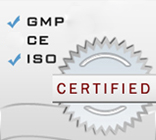 |
EBV-EA-D IgM ELISA Kit description:
The Diagnostic Automation,Inc. Epstein Barr Virus Early Antigen (EBV-EA-D) IgM Enzyme-linked Immunosorbent Assay (ELISA), is intended for the detection of IgM antibody to Epstein Barr Virus Nuclear Antigen-1 in human sera and plasma.
Detection of the Epstein-Barr virus was first described in 1964 by Epstein, Achong, and Barr using electron microscopic studies of cultured lymphoblasts derived from patients with Burkitt’s lymphoma1. EBV is classified as a member of the herpes-virus family based upon it’s characteristic morphology2,3.
EBV infection may demonstrate a wide spectrum of clinical symptoms. The majority of primary EBV infections are transmitted via saliva, occur during childhood, and are subclinical. Antibody titers to specific EBV antigens correlate with different stages of IM. Both IgM and IgG antibodies to the viral capsid antigen (VCA) peak 3 to 4 weeks after primary EBV infection. IgM anti-VCA declines rapidly and is usually undetectable after 12 weeks. IgG anti-VCA titers decline slowly after peaking but last indefinitely. Antibodies to EBV nuclear antigen (EBNA) detected by anticomplement immunofluorescence develop from 1 month to 6 months after infection; and, like anti-VCA, persist indefinitely6. Antibodies to EBNA indicate that the EBV infection was not recent. EBV early antigen (EA) consists of two components; diffuse (D), and restricted (R). The terms D and R reflect the different patterns of immunofluorescence staining exhibited by the two components. Antibodies to EA may appear transiently for up to three months or longer during the acute phase of IM in 85% of patients7. The antibody response to EA in IM patients is usually to the D component, whereas silent seroconversion to EBV in children may produce antibodies to the R components. A definitive diagnosis of primary EBV infection can be made with 95% of acute phase sera based on antibody titers to VCA, EBNA, and EA7.
ELISA kits - Rapid tests- Drug tests- Pregnancy test - IFA kits - CLIA assays - Serology tests - Instrumentation
©1992 Diagnostic Automation/Cortez Diagnostics Inc. All rights reserved.


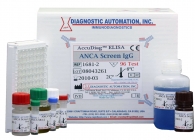 ANCA screen IgG ELISA kit
ANCA screen IgG ELISA kit
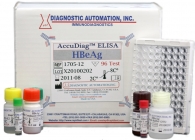 HBeAg ELISA kit
HBeAg ELISA kit
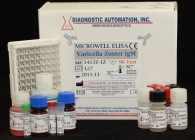 Varicella-Zoster IgM ELISA Test
Varicella-Zoster IgM ELISA Test
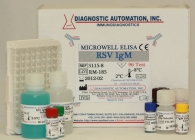 RSV IgM ELISA kit
RSV IgM ELISA kit
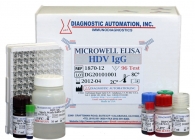 HDV IgG ELISA kit
HDV IgG ELISA kit








